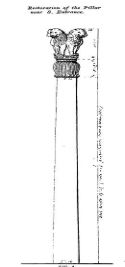


Instruction:
- There will be 2 questions carrying 10 marks each. Write your answers in 150 words
- Any page left blank in the answer-book must be crossed out clearly.
- Evaluated Copy will be re-uploaded on the same thread after 2 days of uploading the copy.
- Discussion of the question and one to one answer improvement session of evaluated copies will be conducted through Google Meet with concerned faculty. You will be informed via mail or SMS for the discussion.
Question #1. Elaborate on the evolution of pillar architecture in early history of India and explain how Ashokan pillar architecture was different from Persian pillar architecture.
Question #2. The Gupta age shows the transitions from cave temples and monolithic shrines to glorified architecture. Discuss with examples.
(Examiner will pay special attention to the candidate's grasp of his/her material, its relevance to the subject chosen, and to his/ her ability to think constructively and to present his/her ideas concisely, logically and effectively).
STEPS & INSTRUCTIONS for uploading the answers
Step 1 - The Question for the day is provided below these instructions. It will be available at 7:00 AM.
Step 2 - Uploading of Answers : Write the answer in A4 Sheet leaving proper margins for comments and feedback and upload the PDF in MY ACCOUNT section. Click on the option of SUBMIT COPY to upload the PDF.
Step 3 - Deadline for Uploading Answers: The students shall upload their answers by 7:00 PM in the evening same day. The first 50 copies will be evaluated.
Step 4 - Feedback : Mentors will give their feedback for the answers uploaded. For more personalised feedback, join our telegram channel by clicking on the link https://t.me/mains_answer_writing_cse . A one-to-one session will be conducted with the faculty after copy evaluation in 72 Hrs.
Model Answer
Question #1. Elaborate on the evolution of pillar architecture in early history of India and explain how Ashokan pillar architecture was different from Persian pillar architecture.
Approach:
- Introduce by writing about pillar architecture. (30 words)
- Elaborate on its evolution since Indus valley civilisation period. (130 words)
- Write differences between Ashokan and Persian pillar architecture. ( 70 words)
- Conclusion. (20 words)
Hints:
Pillars are generally supportive architecture that are utilized to support the buildings and structures giving them strength. But in ancient times they also served the purpose of spreading messages of the state.
Evolution of pillar architecture in India:
- During Indus Valley Civilization, pillars were part of house as supportive structure and were either square or rectangular in shape. The citadel, however, consisted of larger pillars than the lower city.
- During Mauryan period, they were used both as part of Palace to commemorate battle victories and propagate imperial sermons as well as constructed independently to spread the message of Dhamma.
-
- The top portion of the pillar is called capital and it typically has animal figures like bull, lion, elephant, etc.
- These capital figures are carved standing on a square or circular abacus.
- The abacuses are on the base which could be a stylised inverted lotus.
- A long shaft formed the base and was made up of a single piece of stone or monolith.
- Examples: lion capital at Sarnath, Basarah-Bakhira, Rampurva (bull capital), Sankisa and Lauriya-Nandangarh.
- Monumental figures of Yakshas and Yakshinis have been found in various parts of India thus showing the popularity of Yaksha worship.
- Post Mauryan period involved mentioned ‘Garuda pillar’ (at besnagar near vidisha) which was gifted by Greek ambassador Heleodorus to Sunga King.
- Gupta period mentions about the Iron pillar of Mehrauli built by Chandragupta II which was originally placed at Vishnupada (identified presently as Mathura). It is the only mention of pillars in that period.
- The top portion of the pillar is called capital and it typically has animal figures like bull, lion, elephant, etc.
Differences between Ashokan pillars and Persian pillars:
Erection of pillars was common in the Achamenian Empire (Persian Empire) as well. While there were commonalities like the use of polished stones, motifs like lotus, following differences are present:
- Shaft of Ashokan Pillar was smooth and monolithic while the Persian pillars were made by joining stones and had grooves over it.
- While there was no base in Ashokan pillar, Persian pillars had a bell shaped base.
- Ashokan pillars were mainly utilized for serving religious purpose and were of independent standing while Persian pillars were part of state building.
- The pillars of the Kumhrar hall do not have capitals whereas those at Persepolis have elaborate ones
- The shape and ornamentation of the Maurya lotus is different from the Persian ones
Conclusion:
Despite their differences both Ashokan and Persian pillars served their purpose of construction and can be referred to as a good architectural manifestation of their time.
Question #2. The Gupta age shows the transitions from cave temples and monolithic shrines to glorified architecture. Discuss with examples.
Approach:
- Briefly introduce with Gupta architecture ( 30 words)
- Discuss transitions from cave temples and monolithic shrines to glorified architecture during Gupta period ( 190 words)
- Conclusion ( 30 words)
Hints:
The Gupta Dynasty (4th-6th century) in North Central India saw the first purpose-built Hindu (and also Buddhist) temples which evolved from the earlier tradition of rock-cut shrines. Adorned with towers and elaborate carvings, these temples were often dedicated to all the Hindu gods. Gupta architecture is very diverse in style, design and features.
Transitions from cave temples and monolithic shrines to glorified architecture during Gupta period
- Rock-cut architecture defines the practice of creating a structure by carving it out of solid natural rock. The craftsman removes rock not part of the structure until the architectural elements of the excavated interior constitute the only rock left.
- Early examples of rock cut architecture include the Buddhist and Jain cave basadi, temples, and monasteries, many with chandrashalas. The aesthetic nature of those religions inclined their followers to live in natural caves and grottoes in the hillsides, away from the cities, and those became enhanced and embellished over time.
- But the Gupta Age, being an age of intense religion interests, saw the construction of large number of temples and religious architectures in form of monolithic shrines rather than in cave form.
- Two main types of temple were built in the Gupta period. The first consists of a square sanctuary with a pillared porch in front. Both porch and sanctum are post-and-lintel style and without any superstructure. This type of temple answers the simplest needs of worship, a chamber to house the deity and a roof to shelter the devotee.
- The second type of temple also has a square sanctum but with a pyramidal superstructure (sikhara). Among the most interesting examples are a brick temple at Bhitargaon and the Vishnu temple at Deogarh built entirely of stone. The sanctums walls are provided with central projections on the outside that extend from the base of the walls right upto the top of the sikhara (spire). The section of the central offset that extends across the wall has a niche, in which is placed an image. The frame around the sanctum entrance is very elaborate, carved with several bands carrying floral and figural motifs.
- Both the Nagara and Dravidian styles of art evolved during this period. The temples became the symbol of wealth & power.
Conclusion:
Gupta art influenced East and Southeast Asia as trade between regions increased. The Gupta Empire became an important cultural center and influenced nearby kingdoms and regions in Burma, Sri Lanka, and Southeast Asia.


